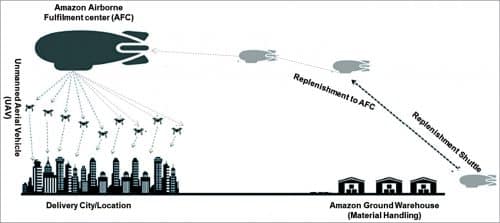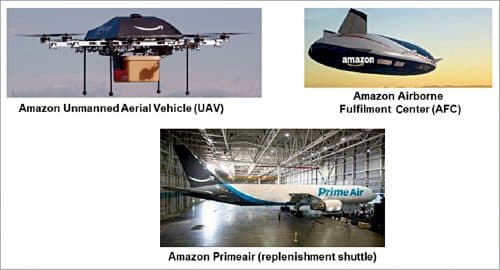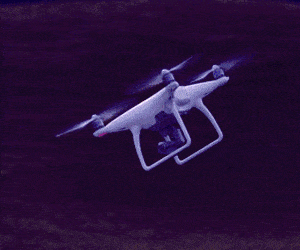This article covers some technologies being considered for the logistics involved in quick delivery of the goods through future drone delivery systems, including a flying warehouse up in the sky.
The advancements in new technologies have changed the world to a large extent. In recent years, the information and communications technology (ICT), artificial intelligence, drones, and robotics have become the focus of intense development, which has led to active convergence between seemingly unrelated sectors.
Logistics is one such sector that is enjoying the recent advancements in technologies. The Internet of Things (IoT) and ICT have automated logistics systems to ensure that all processes from customer order to delivery are performed with hundred percent precision. This allows customers to check delivery status in real time and receive the ordered goods within a few hours.
Another revolution is now underway courtesy drones. The drone delivery system ensures economical and swift services because of maneuverability, flexibility, and low cost. Several logistics companies like DHL, Amazon, FedEx, and Alibaba have introduced drones for goods delivery to their customers. Amazon launched its unmanned aerial vehicle (UAV) delivery service in the UK in December 2016 to deliver packages within thirty minutes of receipt of an order.
A UAV delivery service, however, has some technological limitations. Drones can fly for a limited time only due to power constraints of their lithium batteries, which limits their scalability and serviceability. The logistics companies are therefore developing new systems to deal with the limitation so that they can provide faster service to more customers. One state-of-the-art system is the airborne fulfilment centre (AFC) delivery system of Amazon.
The AFC delivery system was first revealed in April 2016 when Amazon patented a flying warehouse that would deploy UAVs to deliver parcels to customers. In this system, an AFC would store goods as well as small UAVs in the sky at an altitude close to the stratosphere.
When an order is received, a UAV carrying the ordered items would be deployed from the AFC to the customer, as shown in Fig. 1(a). It will return to an Amazon material handling facility (MHF) after performing the task. A shuttle would take off from the MHF and supply inbound and outbound resources to the AFC, as shown in Fig. 1(b).

The AFC delivery system could let customers receive their products within ten minutes of placing the order. The AFC would maintain some inventory so that a UAV can leave with the ordered goods immediately after receipt of the order. The UAV deployed from the AFC would quickly descend towards the customer to deliver the items. During the descent, the UAV would use little or no power. Hence, Amazon would be able to provide faster services to customers located far away and its UAVs would safely return to MHF after delivery.
One of Amazon’s primary objectives is to secure and expand its ecosystem by attracting more sellers and customers to its marketplace. A recent study showed that nearly 25% people are willing to pay a substantial premium for same-day or immediate delivery. The rapid delivery capability of the AFC system can enlarge Amazon’s ecosystem by increasing the number of Amazon Prime subscribers and sellers.
Shipping cost is also a major concern for Amazon, as it incurs a net loss on shipping annually. In this regard, the AFC delivery system can reduce transportation costs and operating energy by staying or moving in the stratosphere where air density and resistance are low. The AFC will use electric and renewable energy such as solar energy. These factors will enable the company to provide a sustainable membership service by reducing shipping costs
American e-commerce giant Amazon now has patents for flying drone warehouse, an underwater warehouse, a bee-hive like warehouse, and mobile ground based fulfilment centres. As per the latest reports from CB Insights, the retail giant has been focussed on shortening the distance between warehouses and consumers for some time. It has considered various formats for warehouse network expansions like flying warehouse, mobile truck mini warehouse, underwater warehouse, local re-stocking stations for drones, and multi-level drone-docking fulfilment centre.
Use of UAVs in industries
UAVs present a powerful tool for collecting data remotely. In inspection scenarios, using a UAV to collect data instead of a person doing so can make a big impact on safety, since it reduces the exposure of personnel to potentially dangerous scenarios such as climbing a cell tower or walking along scaffolding inside a giant tank to collect visual data. People also use UAVs to collect data for surveying, mapping, or even to help investigators find human remains.
Here are the primary types of data currently collected by drones:
Visual data
This is by far the most common type of data a drone is used to collect. By flying over an area or object of interest, a drone can help see things that might not be otherwise visible and collect a record of what is seen.
Thermal data
After visual data, thermal data is one of the most common types of data industries collect using drones. Aerial thermal data can help firefighters determine where to focus their efforts during a raging fire, or help inspectors identify potential problem areas in a solar array.
Lidar data
A light detection and ranging (lidar) sensor ‘illuminates’ a target with a laser light and measures the reflection to create data points that can be used to map the area. Aerial lidar can be used to help companies in various industries to create 3D maps of an area, which can be used for project planning or progress tracking. Since lidar can penetrate tree cover and even earth to reveal structures hidden underground, it has also been used by archaeologists to help them discover new sites of interest for excavation.
Multispectral data. Multispectral data is collected by sensors that measure reflected energy within several specific sections (or bands) of the electromagnetic spectrum. Aerial multispectral data can be used in agriculture and conservation to monitor plant and tree health, and it is also being used by law enforcement agencies to help find human remains.
Hyperspectral data
Hyperspectral sensors measure energy in narrower and more numerous bands than multispectral sensors. Aerial hyperspectral data can be used in agriculture for monitoring the health of crops, and in security and defence for detecting the presence of those who should not be in a given area.
Here are some of the most common deliverables created from drone data:
Photos and videos
One of the most common deliverables for commercial drone work are still photographs and videos. These might be for professional photography or videography purposes (at weddings or family photo shoots), aerial shots of real estate to help market it, or even high-end cinematography for filmmaking.
3D maps
Across various industries 3D maps are becoming a common deliverable for drone data, helping people to better visualise the spaces in which they are working.
Orthomosaics
An orthomosaic is a photo representation of an area created by stitching together several photos. Orthomosaics are used in construction to visualise building sites, in public safety to record the details of places where large groups of people commonly gather, or in civil engineering to track the progress of a large project such as restoring part of a beach.
Actionable reports
In some industries a deliverable produced from drone data could include a report generated by industry-specific software. For example, Pix4D’s agriculture-specific software Pix4Dfields allows users to produce agricultural indices to better understand plant stress as well as aggregating vegetation index maps into zones.
Following are some of the top industries and sectors using drones for commercial purposes today, along with the ways that they are using them:
Agriculture
Farmers use drones to collect data on their crops and then use that data to improve their yields.
Chemicals
Drones are being used in the chemicals industry to improve indoor inspections by taking the place of inspectors in collecting visual data inside large assets used in chemical processes.
Conservation
One of the main ways drones are helping conservation efforts is by providing detailed vegetation maps to help track forestry work and water mapping to better understand how water moves through an area. Drones that shoot out seeds from the air have also been invented, which could help reforestation efforts in places that have been clear cut.
Construction
Mapping and surveying construction sites can be quite slow when done by walking a site. Drones help speed up these efforts, allowing construction companies to provide real-time maps of progress and surveys that can help them both plan for projects and improve projects that are underway, leading to significant savings.
Delivery
Consumer drone delivery has yet to be rolled out at a large scale anywhere in the world but it does present a major contribution for commercial drones. Medical drone delivery is currently taking place throughout the world in countries as far-reaching as Rwanda, the US, and Switzerland (where Flyability is headquartered).
Filmmaking
For years now, high-end drones have been used instead of helicopters to capture aerial shots for movies as latter are more expensive and cumbersome to work with.
Mining
Mining companies are turning to tough indoor drones like the Elios 2 to help them create maps of their mines. These maps lead to improved safety and can also help companies locate ore that might otherwise be lost.
Insurance
Insurance companies are always processing claims, especially after large storms. Drones are helping insurance companies process claims on roof damage much more quickly by allowing adjusters to collect visual data from the sky instead of by climbing up ladders. Insurance companies are also using drones for accident reconstruction, helping them to piece together how an auto collision took place so that they can verify the validity of auto-related insurance claims.
Oil & Gas
Indoor drones like the Elios 2 are making a big impact in oil & gas industry by providing inspectors with a tool for collecting high-quality visual data inside assets crucial to the oil refining process such as tanks and FCC units, and risers.
Power generation
In power generation, indoor drones are also helping inspectors to access areas that would otherwise be difficult to reach. Drones can also help keep inspectors away from the possibility of harm by radiation at nuclear power plants by taking the place of inspectors in collecting visual data of key assets like boilers.
Public safety
Law enforcement, fire departments, and search and rescue have all adopted drones over the last several years. Police use drones to help them get better situational awareness and to map densely populated areas, firefighters use drones to collect thermal data that can pinpoint where they should focus their efforts, and search and rescue personnel are using both thermal and visual sensors on drones to help find people missing in the wilderness.
Sewer maintenance
Indoor drones have been helping inspectors enter city sewer systems to collect visual data that can be used to identify the source of a problem or to evaluate the condition of the infrastructure as part of the regular maintenance process.
Amazon’s flying warehouse – technical aspects
American e-commerce giant Amazon will fly a warehouse at an altitude of around 13,700 metres (45,000 feet) that would act as a launch pad for UAVs, with an aim to deliver consignments in a jiffy, media reports announced recently. Amazon, after winning a patent for flying the warehouse in the US, announced plans for an airborne fulfilment centre (AFC) such as an airship.
The airship will be stocked with lots of products and would float at an altitude of around 13,700 metres, it said. When a customer places an order, a drone will fly down and deliver the parcels. Amazon said the process would require little power as the drone will be gliding down rather than having to take off and land.
“When the UAV departs the AFC, it may descend from the high altitude of the AFC using little or no power other than to guide the UAV towards its delivery destination and/or to stabilise the UAV as it descends,” the patent filing explains. The firm revealed several uses for the flying warehouse.
One example is that of a football match where customers may want certain items such as food or merchandise. Ahead of the game, the AFC could stock up on items and deliver these during the game through UAVs when ordered. It could also be used as a giant advertising board, allowing customers to order the items on display, all of which can be ordered within minutes.
The UAVs would be able to communicate with each other via a mesh network to give information such as weather and the best route for driving. These could also recharge on the airship, as per the report. Amazon’s filing explains that the blimp would remain in the air and be refuelled and replenished using a shuttle. This could be a smaller aircraft capable of docking onto the AFC and unloading products as well as fuel.
Business case for Amazon’s flying warehouse
Amazon being the largest online retail shop that maintains warehouses of products from various sellers across geo locations, improving customer experience and turnaround time for delivery of products have been matters of great concern for them. They have conceptualised the flying warehouse which has UAVs deployed for product delivery.
Both Amazon and Walmart have been researching a lot since a decade on improving their customer experience in delivering products to remote locations and simplify product delivery based on various factors including frequently ordered items, urgency in critical orders, and many more. To handle this kind of customer experience, flying warehouse is being experimented and Amazon has received a series of patents for it in 2016 and is making a heavy investment in deployment of AFCs and the UAVs.
Implementation design of Amazon’s flying warehouse
Amazon flying warehouse was conceptualised a decade ago and implementation of the draft design started in 2013 and later matured to its final design in 2016 when it was patented. In August 2020, Amazon got official Federal Aviation Administration (FAA) approval to use drones for medical supply delivery.
The important components in the conceptual design of Amazon flying warehouse, shown in Fig. 2, include the following.

Airborne fulfilment centre (AFC)
This is the flying warehouse, a costly investment, to be built in the sky nearest to the delivery sites. It would be used for storage of products received from a ground warehouse and as parking/flying space for drones. AFC will also have technicians for repairs and maintenance and a support team to handle the packages. It would be a one-time investment of varying size depending on the products to be handled.
Unmanned aerial vehicles (UAVs)
These are small transporting vehicles or carriers that would lift products to deliver as directed by the UAV delivery team. UAVs will be GPS enabled and move as per path programmed for their delivery. Usually, a delivery location or city will be closer to 80 kilometres (50 miles) and the UAV would be expected to deliver within an hour in most cases. UAVs will be tracked and monitored by the support team in AFC to manage the delivery.
Amazon ground warehouse
This is the regular Amazon warehouse where all products are stored by various vendors. Select items from this ground warehouse will be taken to AFC acting as a temporary delivery store for the nearest delivery locations. A single Amazon ground warehouse can be used to provide products for multiple AFC locations.
Replenishment shuttle
It is a carrier flight that takes goods from a ground warehouse to an AFC for delivery later on receipt of order from the nearest locations. Replenishment shuttle will fly as per schedule like once in a week. Any inventory requirement on day-to-day basis will be monitored in ground warehouse and considered for order fulfilment through replenishment shuttle in the next trip.


Future trends
Amazon warehouse is experimenting with medical supply delivery as there is a huge demand to supply urgent medical requirements like oxygen cans, emergency injections, and drugs. UAVs can deliver quickly even in remote locations, which is important in case of emergencies. Walmart is also experimenting with its own flying warehouse concept for quickly delivering daily supplies like pantry items to its premium regular customers.
We can expect Amazon flying warehouse targeting delivery of daily supplies like food and drinks next, after medical supplies, for its regular customers on subscription basis (say, daily delivery to customers with monthly payment from prime customers). As per an article on Amazon flying warehouse on futurism.com, we can expect retail industry to use this disruptive technology to realign supply-chain process. As a result, small retail shops in large cities could get replaced with UAV based delivery in next ten years.
Also, we can expect a cloud of AFCs to be set up across multiple geo-locations in a country (like edge locations) to fulfil and share product delivery across locations. This will enable faster delivery and ensure product availability based on automatic replenishment of the products in demand.
Dr Anand Nayyar is PhD in wireless sensor networks and swarms intelligence. He works at Duy Tan University, Vietnam. He loves to explore open source technologies, IoT, cloud computing, deep learning, and cyber security
Dr Magesh Kasthuri is a senior distinguished member of the technical staff and principal consultant at Wipro Ltd. This article expresses his views and not that of Wipro.




